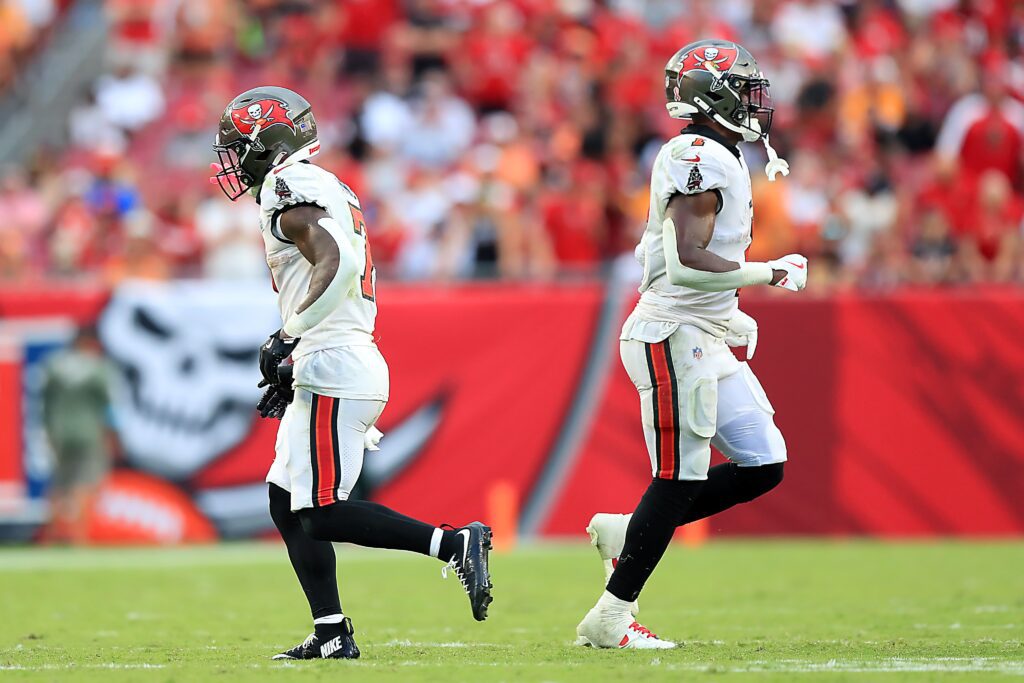Rachaad White and Bucky Irving’s contrasting skill sets could be the key to unlocking the full potential of the Tampa Bay Buccaneers’ offense, but it’s their distinct approaches to the game that stir debate among fans. White, in his second season, has proven to be a well-rounded back, often described as a reliable pass-catcher who can run routes as well as many slot receivers. His ability to block blitzes and serve as a dependable check-down option makes him a vital cog in the team’s passing game, especially on third downs. White thrives in space and shows a level of patience and vision when given room to operate.
Irving, on the other hand, brings a different kind of energy. The rookie’s dynamic burst and shifty running style have earned him comparisons to other great power runners. His ability to elude tackles and find gaps in tight situations adds an edge to the Bucs’ ground game that White doesn’t always provide. While still developing as a blocker, Irving has already shown flashes of brilliance that suggest he could become the primary workhorse back in future seasons. His standout rushing ability was on display in recent games, where he showcased quick cuts, explosive speed, and a nose for finding the end zone on goal-line carries.
What makes this duo interesting is how their differences could be used to elevate the entire offense. White’s polished, multi-dimensional game offers versatility, particularly in high-pressure situations where a team needs a back who can contribute in multiple ways—whether by blocking or catching passes out of the backfield. Irving, however, is the kind of back who can grind down defenses with his physicality, tire them out, and then break away for big plays when least expected.
Incorporating both backs into a cohesive game plan is the challenge for offensive coordinator Liam Coen. Coen himself has admitted that he’s still in the process of figuring out how to best use these two talented players to maximize the offense’s efficiency. One idea that’s been floated around is using White more in the slot, utilizing his excellent hands and route-running abilities, while allowing Irving to dominate the early downs and short-yardage situations. This could create mismatches for defenses, forcing them to account for two very different types of threats at all times.
This conversation opens up intriguing possibilities for how Tampa Bay can attack defenses. Could the Bucs adopt a two-back set more frequently, forcing opponents to bring extra defenders into the box, which would leave wide receivers like Mike Evans and Chris Godwin in more favorable one-on-one matchups? The potential for mixing White and Irving in creative ways seems endless, and it will be up to Coen to capitalize on that versatility.
As the season progresses, fans are left wondering whether Irving’s explosive running style will eventually earn him the starting role or if White’s well-rounded game will keep him in the spotlight. Is there a world where both backs see increased usage without one overshadowing the other? The way Coen leverages their contrasting styles could define Tampa Bay’s offensive success in the weeks to come. Fans, what do you think? Should Irving be given more touches as the season continues, or does White’s consistency in both the run and passing games keep him firmly in the driver’s seat?
Let’s discuss: how would you use these two backs to maximize the Buccaneers’ offensive potential?
FAQs
1. Why have the Bucs chosen to split carries between White and Irving?
By utilizing both backs, the Bucs can exploit their diverse skill sets and keep opposing defenses on their toes. This strategy has led to improved performance on the ground.
2. Will White and Irving’s roles continue to evolve throughout the season?
Yes, the coaching staff is likely to adjust playing time based on performance, ensuring that the hot hand gets more opportunities. This dynamic approach enhances the team’s overall effectiveness.
3. Are the Buccaneers planning to feature a single back in the future?
It seems unlikely, as the success of White and Irving as a duo has proven beneficial for the team. The shared workload strategy has yielded positive results and is expected to continue.


